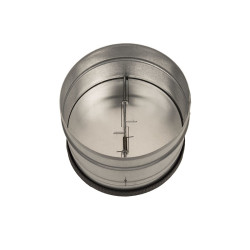- New
- Products
- Pro-line
- More tips
- Brochures
-
About us
You can order products by browsing the website and adding them one by one to the shopping cart.
If you know the product codes, you can also use the Quick Order option, where you only need to enter the codes and quantities into a table and send the table to us. You can access the Quick Order table via the QUIK ORDER link.Make an order using excel sheet download
- Outlet
Do not have the account? Sign up as a reseller or a private consumer.
Sign in
Back pressure valves
No-return valves
The purpose of a backdraft damper is to prevent cold air from entering the room and to reduce moisture buildup in the duct. A malfunctioning backdraft damper can be identified by the presence of cold air felt beneath the stove, especially when the fan has not been used for a long time and the outdoor temperature is significantly lower than the indoor temperature. A faulty damper can lead to moisture accumulation in the duct, which may condense and, in the worst-case scenario, drip into the range hood's motor, potentially causing damage to the motor.
Condensation in the range hood occurs when the humidity in the indoor air condenses on the cold surface inside the duct, forming water droplets. If a...
No-return valves
The purpose of a backdraft damper is to prevent cold air from entering the room and to reduce moisture buildup in the duct. A malfunctioning backdraft damper can be identified by the presence of cold air felt beneath the stove, especially when the fan has not been used for a long time and the outdoor temperature is significantly lower than the indoor temperature. A faulty damper can lead to moisture accumulation in the duct, which may condense and, in the worst-case scenario, drip into the range hood's motor, potentially causing damage to the motor.
Condensation in the range hood occurs when the humidity in the indoor air condenses on the cold surface inside the duct, forming water droplets. If a significant amount of droplets form and drip into the motor or onto the stove, the issue is likely due to inadequate duct insulation or overpressurized ventilation. In such cases, the cause must be identified and addressed.
A backdraft damper is always necessary when a range hood or stove hood with its own motor is connected to an individual duct. The damper is installed when the motor of the range hood expels air through the duct to the outside or when an X1 roof fan is used in conjunction with the stove hood.
However, a backdraft damper is not required in motorized range hoods if an activated carbon filter is in use.
There are 2 products.

